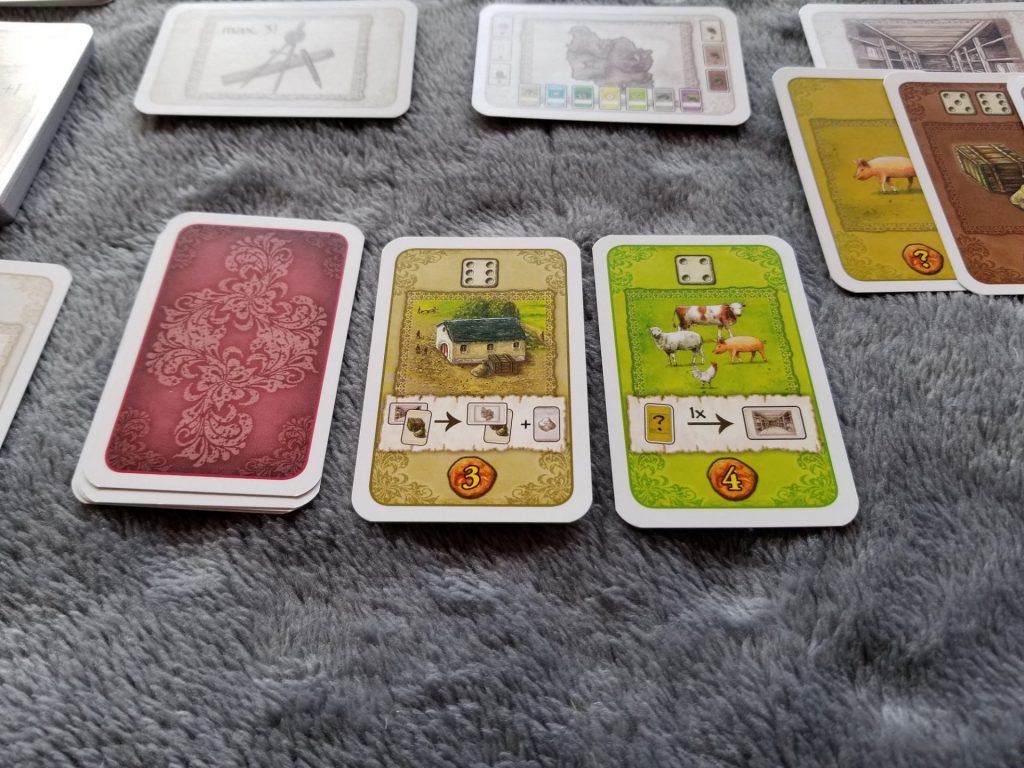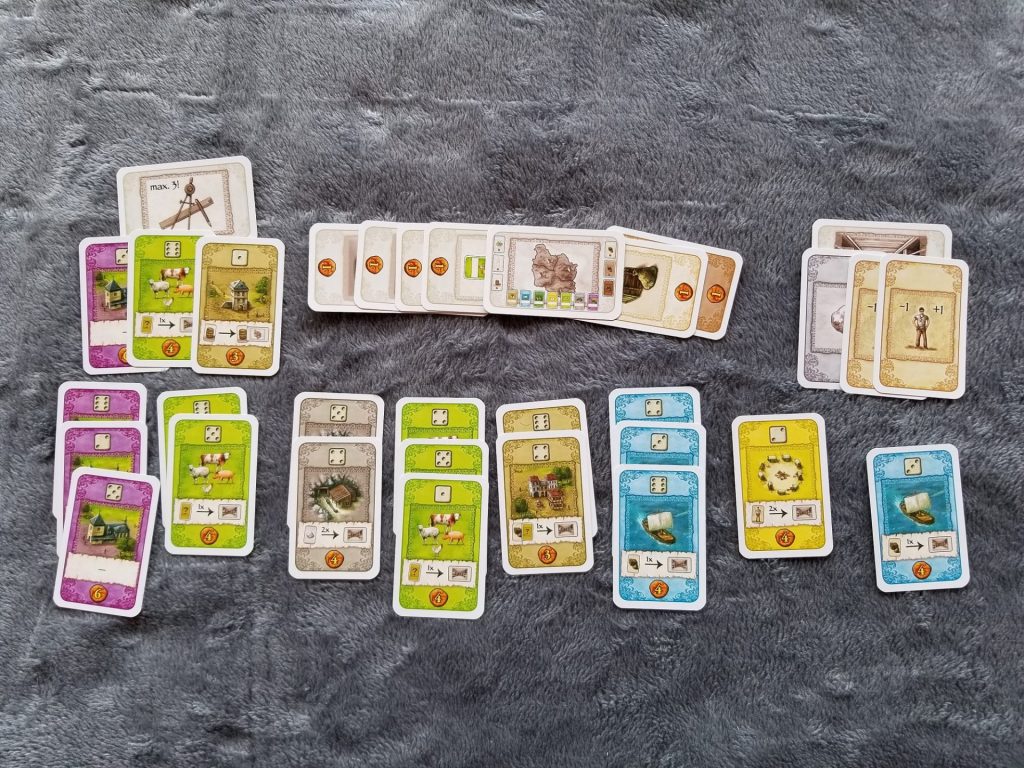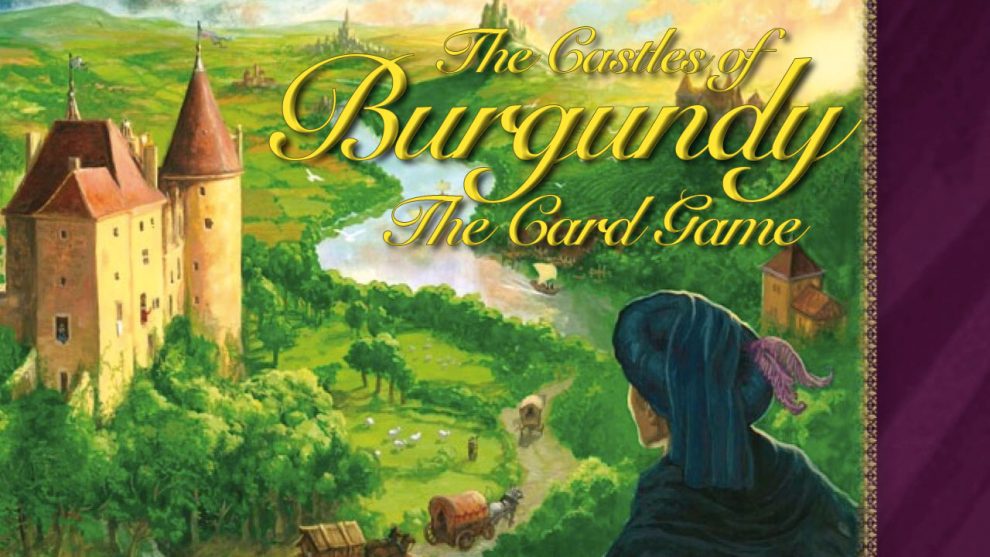Hello and welcome to ‘Focused on Feld’. In my Focused on Feld series of reviews, I am working my way through Stefan Feld’s entire catalogue. Over the years, I have hunted down and collected every title he has ever put out. Needless to say, I’m a fan of his work. I’m such a fan, in fact, that when I noticed there were no active Stefan Feld fan groups on Facebook, I created one of my own.
Today we’re going to talk about 2016’s The Castles of Burgundy (the Card Game), his 22nd game.
The Castles of Burgundy was originally released in 2011 and garnered high praise for its innovative mechanics and clever gameplay. Since then, it has been reimagined in 2 different formats — the dice game, published in 2017, and the card game which is the subject of this review. As of the time of this writing, The Castles of Burgundy is the only title that Stefan Feld has ever reimagined in another format.
Overview
If you’ve ever played The Castles of Burgundy (CoB), then the goal of this game should sound familiar: build up your duchy in order to score the most points. What’s changed, though, is how you go about managing that. Instead of using dice to dictate their possible actions for each round, the players will be using the die faces printed on cards flipped from a randomly shuffled deck.
Also, instead of the classic CoB layout where you can see your empty duchy spread out before you while you’re filling it in with tiles (or in the case of the CoB dice game – numbers), you’re going to have an Estate card which you’ll be stacking cards beneath by type. Placing these cards into your estate will trigger the card’s ability (just like placing tiles in CoB) and will also count towards a “triple”. Triples are just a single type of card collected in a stack of three and this is the main way you’ll be scoring points. Points can be scored through other methods as well and the person with the most at the end of the game will be the winner.
Of course, this is a high-level overview of the game. If you’d like to see what I think about the game and how it compares to the other CoB flavors, feel free to skip ahead to the Thoughts section. If you’d like an idea of how the game plays, keep on reading.
Setup
A game of The Castles of Burgundy – the Card Game (CoB Cards) will look something like this when you set it up:

Each player will begin the game with a Project, Estate, and Storage card and one Good, one Animal (both randomly drawn), and a single Silver card. Additionally, each player will have six cards randomly drawn from the Action card deck and placed face down in a stack in front of them.
Situated between the players is the display area where players will be taking cards from. This is where the various decks of cards that will be used throughout the course of the game will be situated: two face up stacks of Animal cards, two face up stacks of Goods cards, the Silver cards, the Workers, the Round cards, and the various Bonus cards. As you may have guessed by the game’s subtitle, there are a lot of cards. In fact, there’s nothing inside of the game box other than the rule book and the game cards.
After setting up the game, choose a starting player to take the First Player card. Other players will receive between one and two Worker cards; just how much depends entirely upon where they fall in the turn order. Then you’re ready to begin.
Anatomy of a Round
On the player’s first turn of the round, they will flip over two of the six cards from their face down stack. Then they choose a card to discard for its pip value and perform one of the various actions using that value. Pip values can be adjusted by expending one or more Worker cards. One pip may be added or subtracted for each Worker card spent. You can even change a one into a six and vice versa.

For the sake of brevity, when discussing the different actions that can be performed, assume that when discussing the pip value of the discarded card we are also taking into account any adjustments that have been made by discarding Worker cards. The available actions are:
– Take a card from the display and add it to your storage. Each card in the display is situated in a row to the right of a card displaying a pip value. You can take a card from the row matching the pip value on the card you discarded and place it into your storage. You can only have a maximum of three cards in storage at a time.
– Place a project into your estate. You can take a card from your storage matching the pip value of the discarded card and place it below your Estate card. Matching card types are stacked on top of one another. For instance, the tan Building cards are stacked on top of any other tan Building cards that may be in your estate.
This is important because, as mentioned previously, it’s the main way you’re going to score points. Each card type has a value shown at the bottom. Match three-of-a-kind and you’ll earn those points at the end of the game. Once a group of three has been created, you just start a new grouping of that building type.
The other benefit of placing cards into your Estate is that each card has an associated ability that fires off when the card is placed. If you’ve ever played The Castles of Burgundy or The Castles of Tuscany, this will be familiar to you. For example, when placing a blue Ship card into your estate, you’ll be able to take one of the face up Goods cards and place it into your storage. And this segues nicely into the third action…
– Sell Goods. The pip value of the discarded card determines which Goods you can sell. Goods cards sold this way are moved to the right side of your Estate card and arranged so that the victory point values can be seen. Additionally, you receive one Silver card for each Goods card sold. Selling Goods is also how the First Player card transfers hands.
– Restock Workers to 2 Cards. Regardless of the pip value on the discarded card, you can take Worker cards from the supply until you have, at most, two of them.
– Take 1 Silver. Like the previous action, it doesn’t matter what the pip value of the discarded card is. After discarding it, you can take a Silver card from the supply.
– Convert Workers and/or Silver into victory points. Regardless of the pip value of the discarded card, you may discard Worker and/or Silver cards to earn victory points at a rate of one victory point per every three cards discarded.
– Spend Silver to buy new Action cards. At any time during your turn, even in the middle of performing another action, you can return three Silver cards to the supply to draw three Action cards from the deck and then either place one of them (discarding the other two) as a new project under your Project card or discard it and use it for its action.

I’m not going to go into a lot of detail about what each Action card does when it is placed into your estate. In general, though, they will do things like letting you take Action cards from the layout, place cards from your Storage into your estate, take free Worker cards, etc. Bonus cards can be earned (for additional victory points) by being the first player to meet certain objectives or for completing a triple. Figuring out ways to use one card’s ability to trigger another’s to place cards and gain bonuses in the course of a single turn is tantamount to performing well and is what most of the game’s challenge stems from.
End Game
Each round will end after the players have used their six cards. The game ends after five such rounds have been completed. Bonus points will be earned for having collections of different animals and the player holding the First Player card will earn an extra point. These points added to all the other points players have earned during the game will be their final score. The person with the most points wins.
Thoughts
As you may have surmised from the subtitle of this review, I think that CoB Cards is the worst implementation of an absolutely stellar game. It isn’t so much that CoB Cards is a bad game (it isn’t). It’s that it’s overly convoluted and takes up way too much space for it to be worth the time it takes to pull it out, teach it, and play it. To quote Ian Malcolm from Jurassic Park: “Yeah, yeah, but your scientists were so preoccupied with whether or not they could, that they didn’t stop to think whether they should.” Is it possible to turn CoB into a card game? The evidence clearly says it’s possible. But should they have? That’s debatable.
My biggest gripe about CoB Cards is that it’s a table hog. No reimplementation of a board game should ever take up more space than the board game it’s implementing. CoB Dice worked because it was able to fit that big CoB game play into such a tiny package. There’s just something joyful about being able to carry around CoB in your pocket. I cannot overstate how pleasurable it is to be able to whip out CoB and play it at a restaurant while waiting for your food to arrive or to pass the time on an airplane ride.
CoB Cards has none of that. The game comes packaged inside of the same size box as CoB Dice and that may lead you to think that it’s going to be a similar small, portable CoB experience. But you’re being lied to. Everything about the game is massive and sprawling. I play the game mainly at the two player count. Even using standard euro-sized cards (think Catan) it still manages to take up the entire table. And that issue just becomes compounded when you add in even more players.

The other thing that bothers me about the game is how convoluted it is. Maybe it’s just that I am so used to playing CoB that I’ve gotten used to the way things work, but it feels like there are just so many more elements and niggling rules to keep up with in this version. Silver works differently. Knowledge cards work differently. The way points are scored works differently. With CoB Dice, I was able to take my knowledge of its namesake and apply that to what I was doing, but that kind of knowledge application just isn’t feasible in this version. Every time I play, I have to relearn the way that CoB Cards works and unlearn CoB and that’s just grating.
All that being said, CoB Cards isn’t a terrible game. Don’t get me wrong. It’s REALLY good and it definitely gives you that feeling of a game of CoB, only in a card based format. It’s just not a version that I choose to play very often. For the effort put into the setup and the teaching, for the amount of space that gets gobbled up, I’d rather just set up and play CoB. There are only two aspects of CoB Cards that outshine its namesake: a.) it’s cheaper and b.) the box takes up less space. And, for me, that’s not enough reason to ever choose CoB Cards over CoB. I’m glad it’s part of my collection, but unless you’re really into Stefan Feld like I am, this isn’t a version of The Castles of Burgundy that you’ll ever need. There just isn’t enough differentiation to make it worth your time or your table space.












Add Comment